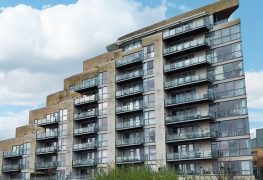A group of leading professional institutions and industry bodies have come together in a bid to make the Government’s Future Buildings Standard more ambitious. The group says this is necessary if the UK is to achieve its target of net-zero by 2050.
What is the Future Building Standard?
The Future Buildings Standard was published in January 2021 by the Ministry of Housing, Communities & Local Government (MHCLG) for consultation on the second stage of its two-part consultation. The idea of the Future Buildings Standard is to provide a pathway to highly efficient non-domestic buildings which are zero carbon ready, better for the environment, and fit for the future.
What are the objectives of Future Buildings Standard?
The vision of the Future Buildings Standard is to transition non-domestic buildings to use low-carbon heat sources for heating and hot water. This in turn would mean that new buildings constructed to the standard would be fit for the future with the ability to become carbon neutral over time as the electricity grid and heat networks decarbonise.
The proposals to be introduced in 2025 for non-domestic buildings include:
Interim uplift to part L of the Building Regulations standards (conservation of fuel and power)
- Primary energy to be introduced as the principal performance metric for new non-domestic buildings, with the continued use of CO2 as a secondary metric.
- An uplift of the minimum energy efficiency standards for whole building energy performance.
- Technical updates for the ‘notional building’ used in the National Calculation Methodology, including a proposal to balance the need to encourage the use of existing heat networks in non-domestic buildings with the need to incentivise new heat networks to be low carbon.
- An increase to the minimum standards for thermal elements (i.e. walls, floors, roofs) and controlled fittings (e.g. windows, rooflights and doors).
- An uplift to the minimum standards for replacement thermal elements (i.e. walls, floors, roofs) and controlled fittings (e.g. windows, rooflights and doors).
- Changes to the minimum standards for building services for new and existing non-domestic buildings. This includes proposals to introduce a new regulation to ensure buildings have self-regulating devices when a heating appliance is installed, as well as building automation and control systems.
- Recalibration of relaxation factors to be applied to modular and portable buildings.
- Introduction of a new airtightness testing methodology.
- Update to energy sub-metering in monitoring the as-built performance of non-domestic buildings; and
- Views sought on what transitional arrangements should apply to new non-domestic buildings.
Interim Uplift to Part F of the Building Regulations (ventilation)
- Changes to the approved part F of the building regulations (2010 edition incorporating 2010 and 2013 amendments) to simplify the guidance in line with the principles presented in the Future Homes Standard consultation; and
- Measures to mitigate the transmission of infection via aerosols in certain non-domestic buildings.
Who believes the Future Building Standard proposals are not ambitious enough?
On 13th April 2021, a group of professional institutions and industry professionals wrote to Jeremy Pocklington, Permanent Secretary of the MHCLG, outlining their concerns and recommendations. The group comprise:
- Active Building Centre
- Architects Climate Action Network (ACAN)
- Architects Declare
- Association for Environment Conscious Building (AECB)
- Building Performance Network (BPN)
- Chartered Institute of Building (CIOB)
- Chartered Institution of Building Services Engineers (CIBSE)
- E3G Energy Saving Trust London Energy Transformation Initiative (LETI)
- Friends of the Earth
- Good Homes Alliance
- Greenpeace
- MCS Foundation
- National Energy Foundation (NEF)
- New London Architecture (NLA)
- Passivhaus Trust
- Royal Institute of British Architects (RIBA)
- Royal Town Planning Institute (RTPI)
- The Alliance for Sustainable Building Products (ASBP)
- UK Green Building Council (UKGBC)
Why is the Future Buildings Standard not ambitious enough?
The letter states “we believe that there are several additional areas that are critical to success in achieving the UK’s net zero ambition, and with the right decision, the UK can demonstrate global leadership and create a world-leading build environment sector”.
The recommendations put forward to enable the Government to achieve its targets were:
- Start regulating total energy consumption rather than introduce primary energy.
- Set actual energy performance targets for buildings.
- Ensure new buildings are really on track for net zero carbon, with low energy demand and no fossil fuels.
- Assess building performance better to close the performance gap.
- Introduce and regulate embodied carbon targets for buildings.
- Set a clear National Retrofit Strategy.
Who else supports this view?
According to an article by Building Magazine, “commercial developers including Land Securities, British Land, and Grosvenor have announced that they want their property portfolios to be net-zero carbon by 2030” as opposed to the Government’s target for the UK to bring all greenhouse gas emissions to net-zero by 2050. The article also notes that local authorities including the Greater London Authority (GLA) have required new developments to improve part L requirements as a condition of planning approval.
What next?
The consultation closed this month (April 2021) and gives the MHCLG time to consider the feedback received before publishing their interim uplift to parts F and L and before overriding regulation commences. The Future Buildings Standard is due to be published in 2024 before coming into force in 2025.
For further reading on this subject below are some links to useful articles and information:
https://assets.publishing.service.gov.uk/government/uploads/system/uploads/attachment_data/file/956037/Future_Buildings_Standard_consultation_document.pdf
https://www.ciob.org/media-centre/news/ciob-amongst-bodies-demanding-more-ambitious-future-buildings-standard
https://www.ciob.org/media/390/download
https://www.building.co.uk/buildings/explainer-the-proposed-future-buildings-standard-in-detail/5110123.article
What does this mean for your project?
If you have a non-domestic project underway, or in the planning phase and would like to know how the Future Buildings Standard may impact, or to talk to an expert, please click the button below or call 02380 405073.





